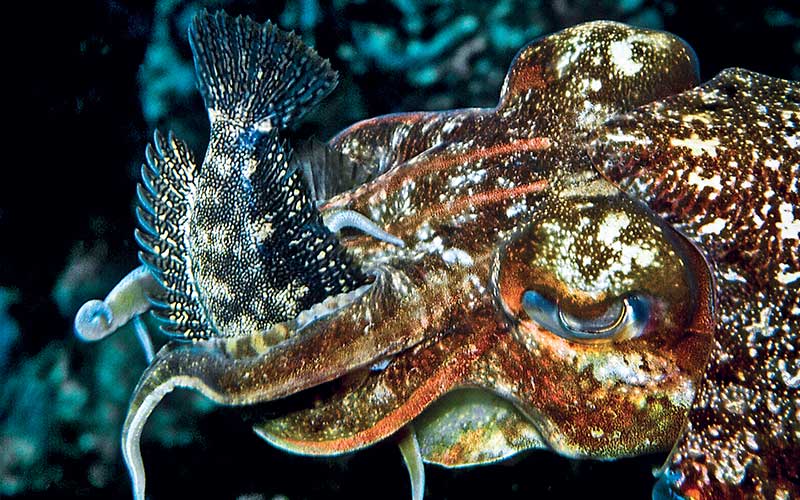There is nothing quite like getting close to an animal in the wild. The sea offers some of the best up close and personal animal encounters on the planet, with many great marine creatures seemingly content to go about their daily routines with spectators only a few feet away. Such is the case with the broadclub cuttlefish, a rather common, football-sized cephalopod that ranges from the eastern fringes of the Indian Ocean to Fiji in the Pacific. Although Anna and I have spent many hours observing broadclubs in the past, the species is so approachable and full of surprises that we never swim past without giving them a bit of our time. An encounter last spring proves why.
Anna sights a lone cuttlefish weaving its way through a gorgonian thicket that skirts an ancient lava flow on the southern shore of Alor, in Indonesia. The animal blends so masterfully with its backdrop that if it weren’t for its movement, Anna would have missed it altogether. Like their close relatives octopus and squid, cuttlefish are famous for brainpower as well as their talent for intra-species communications and altering color patterns for camouflage (as a group, cephalopods exhibit the most diverse repertoires of chromatic displays nature has to offer). This remarkable adaptation is driven by a visual analysis of surroundings. The information is transferred via nerve impulses to overlapping layers of muscle-lined, pigmented skin organs, known as chromatophores. When stimulated, the tiny organs expand, intensifying color; when the muscles relax, they contract and pale. The ability to change body patterns rapidly is a powerful tool particularly important to broadclubs, one of the few cuttlefish species that hunts during the day.
As we trail a few feet behind, the cuttlefish orchestrates its chromatophores to perfection, instantly brightening when it emerges into the light and reverting to a mottled brown when it eases into the shadows. Suddenly the broadclub stops in its tracks only a few inches off the bottom, turns pale and forms a cone with six arms while extending a single arm to each side of its head for stability. To our amazement, it then sends pulsing light bands streaming down its body, much like a flickering theater marquee. Ever so slowly, the tips of two elastic feeding tentacles emerge from the cone. Faster than our eyes can follow, the tentacles shoot forward, and a small wrasse more than two feet away disappears.
The action is so fast, and we are so startled, it is impossible to be certain if the fish was captured or dodged inside a hiding hole; however, the cuttlefish works its arms like it is consuming prey with powerful beak-like jaws hidden at the base of its sucker-lined arms. Within a minute, the hunter reverts to its cryptic coloration and goes back on the prowl. Ready this time, we move in even closer as the cuttlefish triggers its light show once again. This time a damselfish is the target.

No one is quite certain how the ghostly flashes, known as the passing cloud display, aid the hunt, but in each of a dozen feeding attempts we witness, the behavior, which possibly mesmerizes the prey, is employed before the club-tipped tentacles shoot forward with the speed of a chameleon’s tongue. It seems impossible that the sharp-eyed damselfish isn’t aware of such a hulking predator hovering less than a meter away, but the fish makes no move to escape before tentacles fly.
Like so often happens in the sea, as soon as we think we understand the cuttlefish’s feeding style, it begins patrolling along the edge of the lava flow just beneath the surface. In a blur of bubbles it strikes the waterline. To our delight, the cuttlefish, as if showing off a trophy, swims to within an arm’s length of where we kneel. This time there is no doubt of success; the flapping tail of a blenny extends from the powerful web of arms.
Explore More
© Alert Diver — Q4 Fall 2010